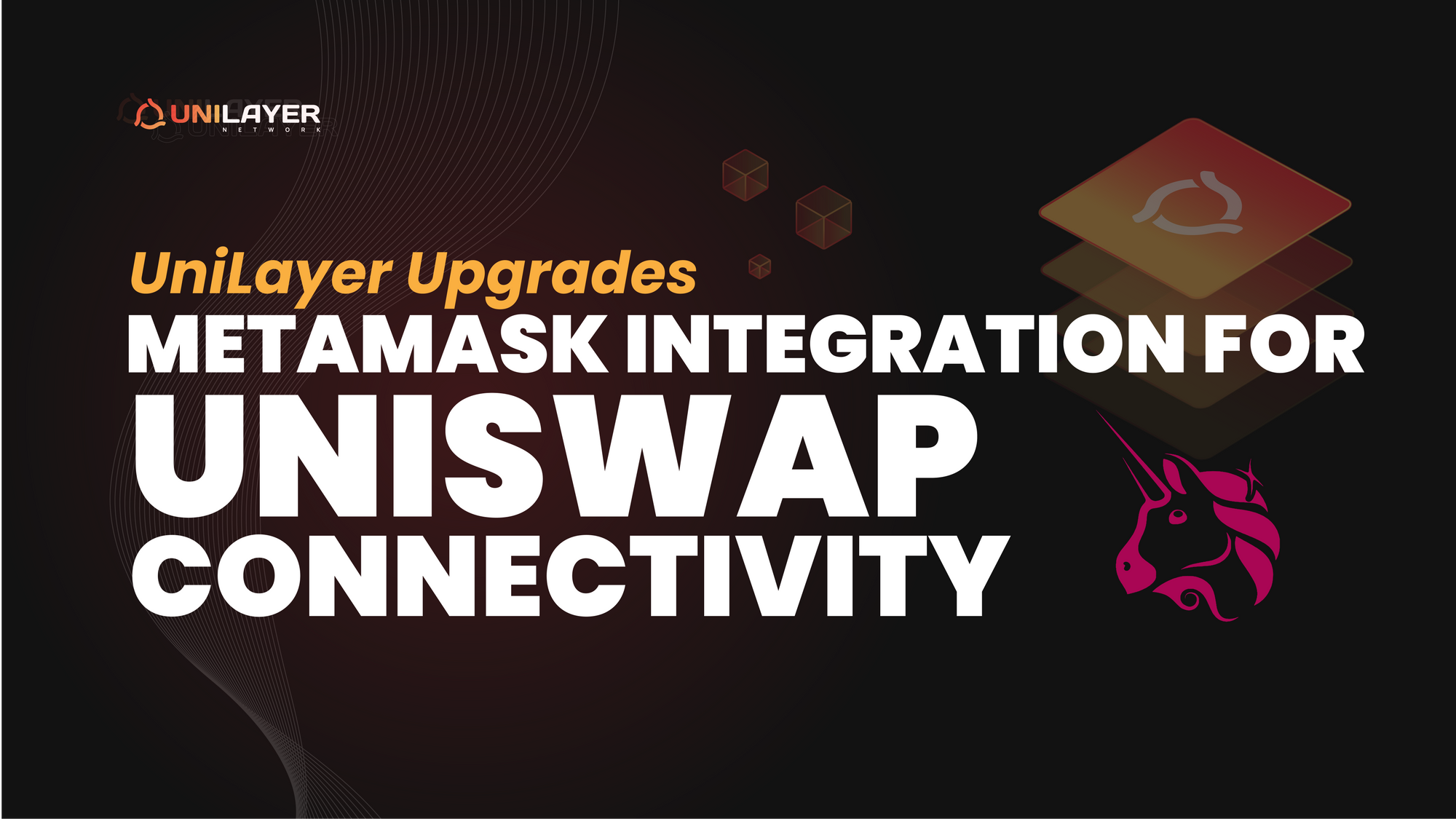UniLayer Upgrades MetaMask Integration for Uniswap Connectivity

Imagine being able to seamlessly swap between Bitcoin and any ERC-20 token on your trusted Metamask wallet; or having cross-chain access to the most popular DeFi platforms - regardless of network of origin - through a completely on-chain interoperable infrastructure; envision creating cross-chain, fungible or non-fungible tokens (NFTs); or, with a single click, deploying smart contracts that connect and coordinate multiple blockchains at once. This is UniLayer’s vision, and it is one that UniLayer is, step-by-step, making a reality.
Recently, the UniLayer team has taken a major step toward true, decentralized interoperability and next-level adoption through the development of UniLayer’s MetaMask integration. Having already launched the testnet, the team’s next step is to redirect UniLayer’s focus toward constructing a comprehensive infrastructure to maximize UniLayer’s impact on mainnet launch. This means bringing UniLayer’s cross-chain capabilities to existing users on the most widely-used blockchain infrastructure platforms, with popular non-custodial wallet, MetaMask, a clear top priority.
MetaMask boasts over 21 million active monthly users, and connects to a wide array of DApps: MetaMask wallet holders can access major DEXs (like Uniswap), NFT marketplaces (OpenSea and Rarible), and leading DeFi and gaming platforms. However, despite the plethora of existing options, MetaMask has always been an exclusively Ethereum-based wallet.
Until now.
Breaking New Ground With MetaMask
“We need to support popular tools. We cannot change them, nor fork them. The only way forward is to invent a direct way of interacting with them.”
- Alex Belets, CEO of UniLayer
Thus far, no network outside of the ERC-20 token standard has succeeded in joining with MetaMask. Qtum, a fork of Bitcoin, chose to fork MetaMask, largely because its architectural design does not lend itself to easy integration with the wallet. Qtum and Bitcoin are built with the UTXO (unspent transaction output) model, in contrast to Ethereum’s account-based model, for which MetaMask was designed. (The UTXO model provides greater security for newer blockchains.)
For a comparison of UTXO versus account-based models, click here.
UniLayer uses the UTXO model as well, which has made the MetaMask integration a major challenge and achievement. Recently, the UniLayer team embarked on an intensive “speed run” to complete significant updates to allow users to hold ULR tokens (UniLayer tokens) in their MetaMask wallets, send or receive them, and, in the future, swap them for any ERC-20 token on Uniswap or other, similar DEXs.
In addition, users can utilize the UniLayer platform to create new tokens (including NFTs) or any other smart contracts, with the click of a button.
All UniLayer's developments undergo audits by the reputable blockchain security firm, Smart State, UniLayer’s longtime partner, ensuring the highest standard of security and functionality for UniLayer’s interoperable layer-1 platform.
UniLayer and Uniswap
One of the most exciting use cases for UniLayer’s interoperable cross-chain network is decentralized token swaps, Uniswap being the standard bearer of that sector. As of March 2023, Uniswap holds an over 70% share of the DEX market, and even during the current bear market, still boasts half a billion dollars in daily trading volume.
Significantly, interoperability has long been an essential goal for Uniswap. While it currently offers support for not only Ethereum, but also Polygon, Celo, BNB Chain, Arbitrum, and Optimism, each of these chains is still “siloed”: unable to interact or share liquidity.
The search for a real, viable cross-chain solution has never been more urgent or controversial, as demonstrated by the recent heated Uniswap DAO debate, which pitted up-and-coming bridges, including LayerZero, Celer, and Wormhole, against one another. Each bridge protocol received marked criticism for particular design flaws, with more than a few DAO members reaching the conclusion that no single bridge would provide adequate and comprehensive security.
The notorious hacks of Axie Infinity’s Ronin bridge and Harmony’s Horizon Bridge - not to mention the Wormhole attack - have prompted many users and developers to be hesitant to rely on yet another bridge protocol, with all the associated vulnerabilities and risks that come with centralized components.
What UniLayer offers is a paradigm shift: security built on a foundation of “Dual Nodes”, or Universal Nodes, (nodes that validate transactions on both the UniLayer network and their native network, be that Bitcoin, Ethereum, or others), working in tandem with UniLayer’s secure “Logix” smart contracts.
UniLayer presents an alternative vision of interoperability, thanks to its layer-1 network architecture, designed from the ground up, for secure, decentralized, and nearly feeless interoperability.
UniLayer, Bitcoin, and Ethereum
Bitcoin and Ethereum have traditionally held distinct roles in the blockchain space: the former, the ubiquitous and enduring store of value, the latter, the premier smart contract platform. Over time, the versatility and utility of both networks have grown and evolved, with Bitcoin embracing the BRC-20 standard (and its NFT-like ordinals) and Ethereum gaining traction as a secondary store of value. However, a major gap persists between the two largest blockchain networks, both in terms of respective utility and cross-chain compatibility.
UniLayer represents a synthesis of the two network approaches, as it is a Bitcoin-family blockchain (operating with the UTXO model) that is smart contract capable. Furthermore, as evidenced by the MetaMask integration, UniLayer is progressing toward a seamless integration between the two very distinct networks (and architectural models). UniLayer intends to unlock the liquidity - and offer the security - of both chains for the broader crypto ecosystem, under the banner of true decentralization.
Accessing the UniLayer Network Via MetaMask
Accessing UniLayer through MetaMask is easy: simply configure your wallet to the UniLayer network, and input UniLayer’s RPC url and a few additional parameters.
Please apply to the UniLayer testnet for specific instructions.
Currently, the testnet is live - with brief down periods for updates - and UniLayer’s faucet can provide testnet ULR tokens. Users can send tokens to any other configured wallet address or, in the future, swap them on DEXs, like Uniswap, or use them on any other compatible DApp.
Looking Ahead: Bitcoin/UniLayer Dual Nodes
The UniLayer team is laser focused on building UniLayer’s first interoperable network integration with the blockchain that began it all: Bitcoin. As the team continues work on current testnet updates, we can also look ahead to the implementation of Universal Nodes (aka, Dual Nodes).
Universal Nodes double as native network nodes (on Bitcoin or Ethereum, etc.) and UniLayer nodes. By running the validator software of both blockchains, node holders receive rewards from two networks, in the form of Bitcoin (for instance) and UniLayer tokens (ULR). This effortless incentive encourages node operators to join, power and secure the UniLayer network, as we build out a secure and scalable interoperable network for all.
- - -
UniLayer is actively building the foundation for a new era of blockchain technology. UniLayer's user-friendly interface and robust infrastructure are paving the way for a future in which seamless cross-chain interactions are the norm.
Stay in touch and get involved today!
To learn more about UniLayer and where we’re headed, visit UniLayer.io.
To stay up to date on the MetaMask and Bitcoin integrations, and more, follow us on Twitter.
To join our growing community and talk to the team directly, visit UniLayer’s official Discord.

